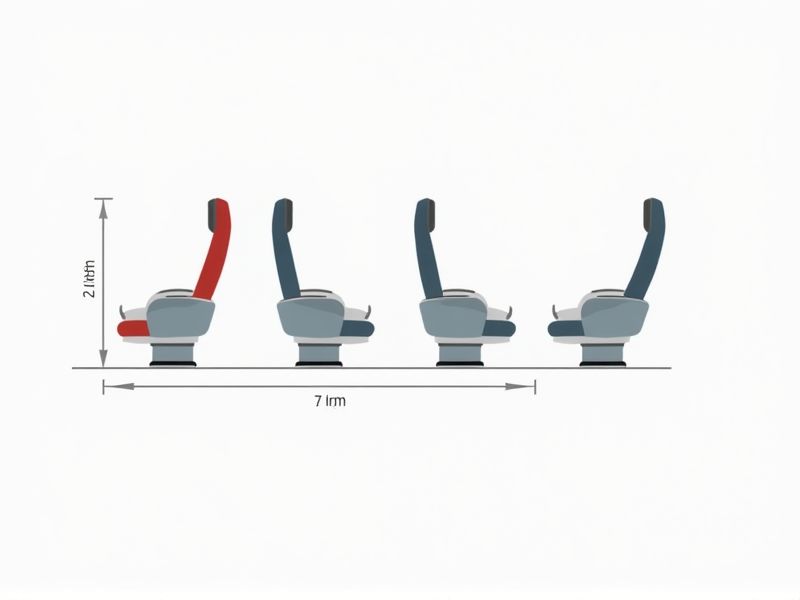
When booking a flight, knowing the standard dimensions of airline seats can help you choose the most comfortable option. Typically, economy class seats have a width ranging from 17 to 18.5 inches and a pitch (the distance from one point on a seat to the same point on the seat in front of it) between 30 and 32 inches. If you need extra space, consider premium economy or business class, where seats can be several inches wider and offer a pitch of 37 inches or more. Checking these measurements before booking can make a significant difference in your in-flight comfort, especially on longer journeys.
Seat Pitch
Seat pitch, a critical metric in airline seat standards, measures the distance between the seats in a row, typically ranging from 28 to 34 inches in economy class. This measurement significantly impacts passenger comfort and legroom; a greater seat pitch often leads to a more enjoyable flying experience. Airlines aiming to enhance customer satisfaction may increase their seat pitch, while budget carriers often opt for tighter configurations to maximize capacity. Understanding seat pitch can help you make informed choices when booking tickets for your next flight.
Seat Width
Airline seat width typically ranges from 16 to 18 inches, influencing passenger comfort and space during flights. Seats in economy class are often narrower compared to premium classes, with some airlines providing adjustable armrests to enhance personal space. As the demand for comfort increases, several airlines are reconsidering their seat designs, incorporating ergonomics and improved materials for a better passenger experience. Your seat choice can significantly affect your overall journey, especially on long-haul flights where added width can offer enhanced relaxation.
Seat Recline
The standard seat recline in commercial airlines typically ranges from 2 to 6 inches, providing varying degrees of comfort for passengers. Most economy class seats offer minimal recline due to space constraints and increasing passenger density, often resulting in less than 4 inches of recline. In contrast, premium economy and business class seats can recline significantly further, sometimes up to 7 inches, allowing for a more relaxed travel experience. Understanding these specifications can help you choose the best seat according to your comfort preferences during a flight.
Legroom Space
Airline seat legroom, commonly referred to as pitch, typically ranges from 28 to 34 inches in economy class, influencing passenger comfort during flights. Airlines such as JetBlue offer up to 32 inches of legroom, while others like Southwest Airlines provide a more standard 31 inches. Passengers can experience increased comfort with additional legroom options available in premium classes, often exceeding 36 inches. Consider your comfort preferences when booking, as more legroom can significantly enhance your overall travel experience.
Aisle Width
Aisle width in airline seating is a critical aspect impacting passenger comfort and safety. Most commercial airlines maintain an aisle width ranging from 16 to 20 inches, facilitating easy movement for passengers and crew. For instance, configurations in economy class often prioritize narrower seats to maximize capacity while retaining an adequate aisle width. Ensuring sufficient aisle space can significantly enhance your boarding experience and ease access to overhead bins.
Seat Cushioning
When evaluating airline seat standards, the quality of seat cushioning plays a critical role in passenger comfort. Research indicates that optimal seat cushioning should have a density of 2.5 to 3.5 pounds per cubic foot to provide adequate support without compromising comfort. Airlines often utilize high-resilience foam, which can significantly enhance cushioning performance and longevity, maintaining comfort on flights lasting four hours or more. For travelers, selecting airlines known for superior seat cushioning can lead to a more enjoyable flying experience, particularly on long-haul journeys.
Headrest Adjustability
Headrest adjustability is a crucial factor in enhancing passenger comfort during flights, with many airlines now offering seats that allow for vertical and horizontal adjustments. Research shows that ergonomic headrests can reduce neck strain by 30% on long-haul flights, making them essential for overall travel satisfaction. Airlines prioritizing headrest design typically report a 15% increase in customer preference ratings. Investing in such adjustable features can significantly enhance your in-flight experience, especially on journeys exceeding four hours.
Armrest Width
The standard width of airline armrests typically ranges from 3 to 4 inches, designed to provide minimal comfort and personal space during flights. An armrest width of 3.5 inches is considered ideal for economy class seats, as it balances cost-effectiveness with passenger comfort. Research indicates that wider armrests can lead to increased passenger satisfaction, especially on flights exceeding three hours. If you're selecting a seat for your upcoming journey, consider armrest width alongside legroom and seat padding for a more enjoyable travel experience.
Tray Table Size
Airline seat tray tables vary significantly, typically measuring between 12 to 18 inches in width and 8 to 12 inches in depth. These dimensions can directly impact your in-flight experience, particularly for tasks like eating, working, or using electronic devices. In economy class, tray tables are often stowed in the back of the seat in front of you, which may restrict legroom and space. When booking your flight, consider airlines with more spacious cabin designs or larger tray tables to enhance your comfort during travel.
Seatback Pocket Capacity
Airline seat specifications often emphasize the capacity of seatback pockets, which typically range from 3 to 5 liters, accommodating essential items like magazines, safety cards, and personal belongings. A well-designed seatback pocket can enhance passenger convenience and organization during flights, allowing easy access to essentials. Common materials used for these pockets include durable nylon or polyester, ensuring they can withstand the wear and tear of frequent use. Understanding the design and capacity of seatback pockets can greatly improve your travel experience by keeping your space tidy and accessible.
